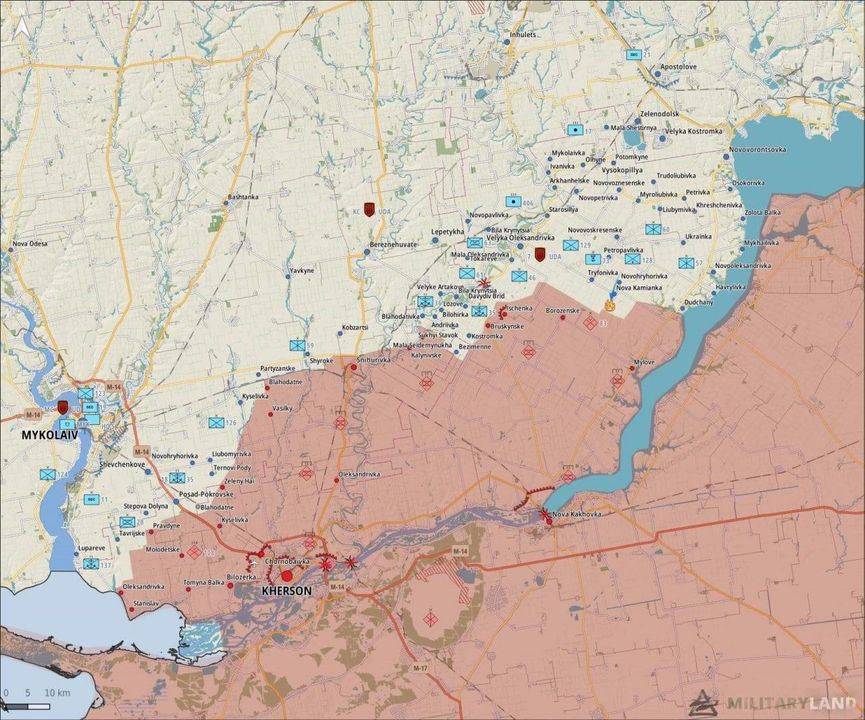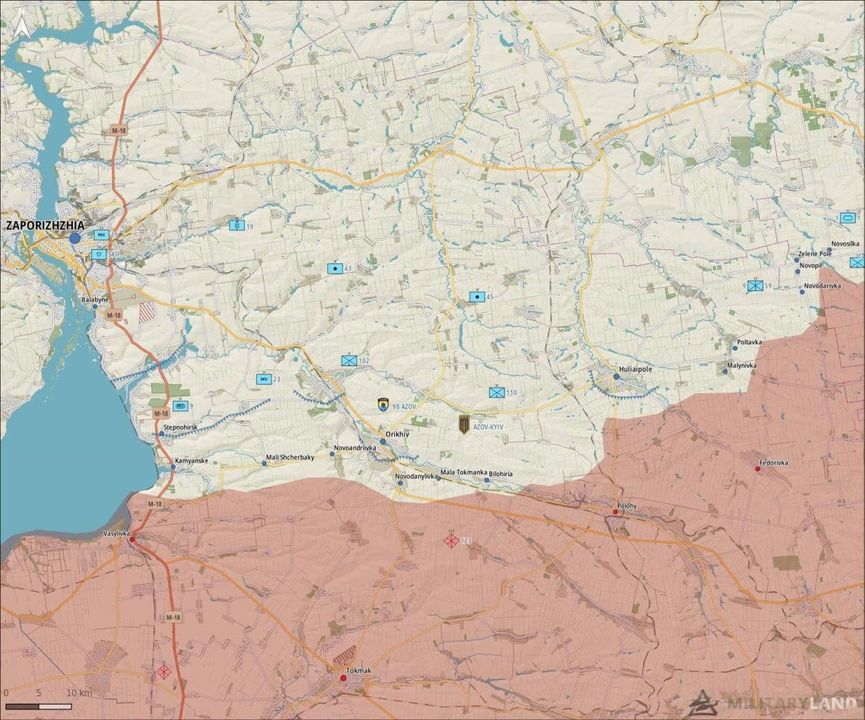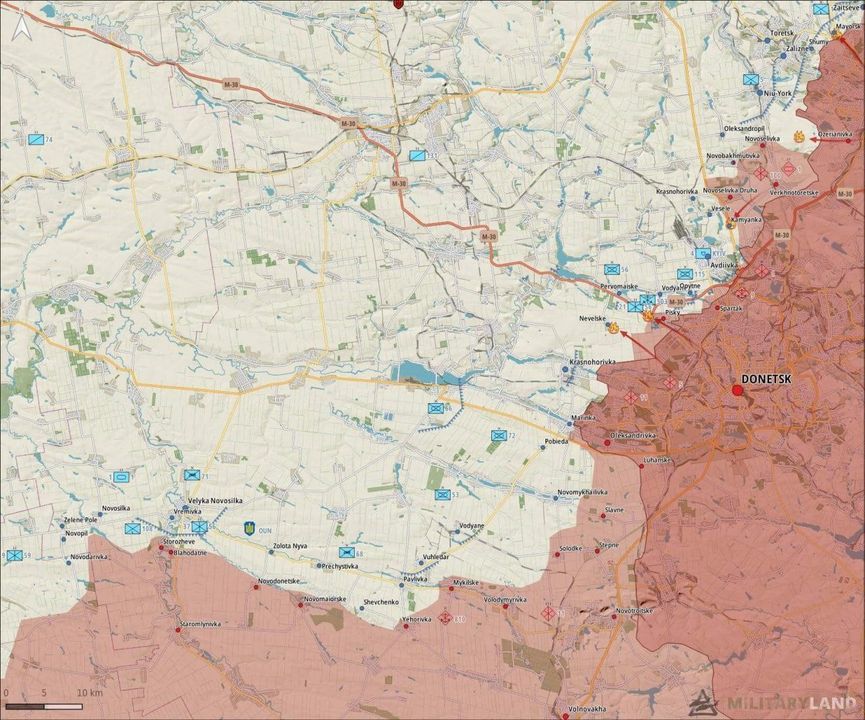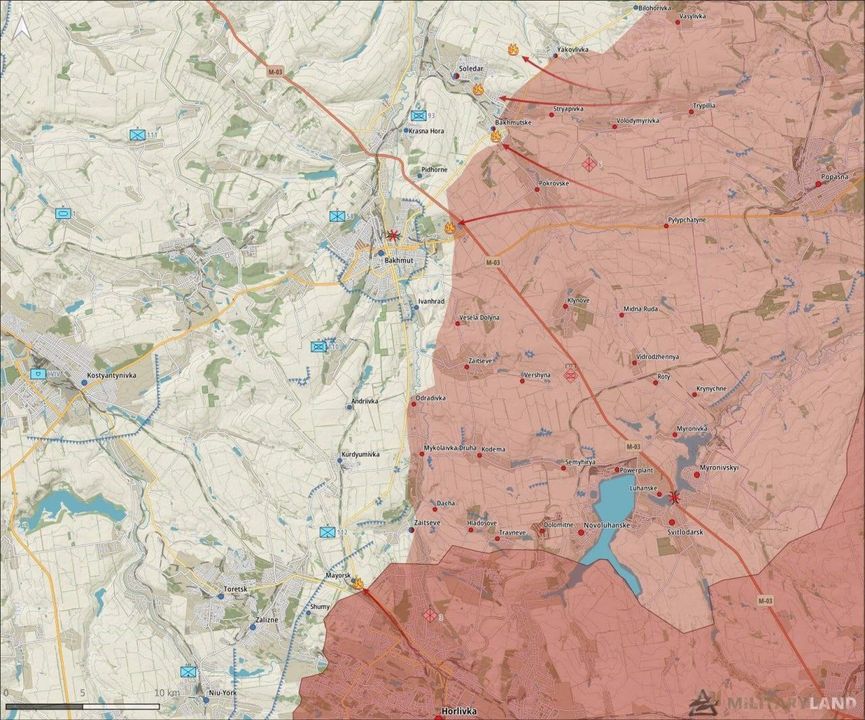Ukraine Update: Day 231

Second Battle of Liman
After having unsuccessfully assaulted the town frontally from the West for several days, Ukrainian forces shifted to more savvy tactics, bypassing strong points and flanking them with the aim of surrounding Liman. By the 25th of September, AFU units were pushing toward Makiivka, trying to take positions north and north-east of Liman. By the 28th of September, Ukrainian troops had managed to create several crossings south of Liman, forcing the Russian garrison to defend on three fronts. AFU troops pushed toward Torske and Zarichne, east of the town, in order to cut off Liman and surround it.
Russian and separatist forces lost Yampil (SE of Liman) on the 30th of September. The last road linking the Russian garrison to their own lines (Kreminna-Torske) was still under Russian control, but under Ukrainian fire. Heavy fighting for Torske ensued. By the 1st of October, the Russian garrison was only holding out thanks to the support of the Russian artillery. Russian reinforcements were sent to hold the Kreminna-Torske road open, preventing the town from being surrounded by Ukrainian forces. AFU units entered Liman from the NW, and the following day, Russian forces withdrew eastward towards Kreminna.

Liman is under Ukrainian control for the first time since the 27th of May 2022. The Russians won the First Battle of Liman, conquering it in 4 days. It took 4 weeks for the Ukrainians to retake it, but retake it they did. Liman train station is the second largest marshalling yard in Ukraine.
The front stabilized in front of Kreminna up until yesterday, with both sides reorganizing and regrouping. There might currently be a Russian counterattack or attempt at counter-attacking on that front. Awaiting confirmation.
Battle for Bakhmut
Slow methodical Russian advances towards Bakhmut. No Blitzkrieg here, but the same tried and tested Russian tactics which consist in methodically probing Ukrainian defenses and calling in artillery fire once enemy positions are revealed. Progress is slow, but the method causes more casualties on the defending Ukrainians than it does on the advancing Russians and separatists: The artillery systematically covers, suppresses, and destroys Ukrainian positions, and Russian infantry conquer rubbles.
The Russians took Spirne on the 27th of September and were on the outskirts of Soledar and Bakhmut by the 1st of October. Wagner contractors (which have led the offensive on Bakhmut for weeks) gained a foothold inside the town’s industrial area (SW) on the 6th of October while DPR units entered Zaitseve (between Bakhmut and Horlivka) the same day. Several smaller settlements southwest of Bakhmut were taken by Russian forces the following two days.

Kherson Front
Ukrainian forces attempted to push out of their Davydiv Brid bridgehead on the 30th of September and 1st of October, without success. On the 2nd of October, Ukrainian forces burst through Russian defenses at Beryslav to a depth of 7km, all the way to Bilyaivka. They repeated that penetration with a second (parallel) thrust along the Dnieper River and advanced 10km to Zolota Balka. By the end of the day, Russian forces had retreated 30km, blowing up bridges at Dudchany in order to slow down pursuing Ukrainian forces.
By the 4th of October, AFU units were pushing across the whole northern line of contact, rolling back Russian units southwards. Russian units that had defended the Davydiv Brid front for two months started to yield. A Ukrainian breakthrough there would have threatened to cut-off Russian forces between Kherson and Krivyi Rih. The Russian command took the decision to pull troops back to a line roughly parallel to Nova Kakhovka in order to shorten the front and avoid getting trapped by the two-pronged Ukrainian attack.
There has been heavy fighting around Dudchany over the past few days but the line seems to have stabilized.

Kharkiv Front
Ukrainian troops managed to cross the Oskil River at Dvorichna, creating a bridgehead on the east bank of the Oskil and threatening Russian positions at Kupyansk from the North. By the 3rd of October, Russian forces started to pull back from the Oskil River, seemingly intending on making a stand at Svatove.
The line is currently stable with the Russians holding Statove.
Let It Rain: Strikes and Counter-Strikes
Russian strikes on Odessa, Slavyansk, Kryvyi Rih, Dnipropetrovsk, Nikolayev, Chuhuiv, Kramatorsk, and Kiev. Ukrainian strikes on Energodar, Kherson, Donetsk, Nova Kakhovka, Starobelsk, Severodonetsk, and Ilovaisk.

Hawks versus Doves
Open criticism flowed against Shoigu and President Putin following the battle of Liman and the setbacks in the Kharkiv and Kherson areas. The inability of the Russian MoD and Western Military District to provide the Liman garrison with reinforcements when needed was highlighted. The Deputy head of the Kherson administration went as far as suggesting Shoigu should shoot himself!
Russian experts criticize Putin for being too soft and prosecuting the war in Ukraine with the hope of negotiating with or gaining concessions from the West. Russian hawks want a total war solely designed to comprehensively defeat Ukraine militarily.

On the 3rd of October, Chechen leader Ramzan Kadyrov called for low yield (tactical) nuclear weapons to be used in Ukraine. Kremlin spokesman Dmitry Peskov said, “The heads of regions have the right to express their point of view, but the Kremlin favors a balanced approach to the issue of nuclear weapons, not based on emotion.”
On the 8th of October, General Sergei Surovikin was appointed commander of the Joint Group of Forces in the area of the Special Military Operation. Shoigu remains at his post nominally, but it seems that Surovikin is now the real man in charge of the Russian armed forces in Ukraine.
Free Money: Financial Aid and Support
On the 26th of September, the US announced another $457.5 million in financial aid to Kiev, this time, to finance the work of Ukrainian law enforcement agencies. This was on the day the US Congress agreed to yet another $12 billion aid package for Ukraine. A tranche worth $1.1 billion was allocated on the 28th of September and included 18 HIMARS, 150 SUVs, several radars and anti-UAVs systems. On the 2nd of October, Bloomberg stated that Washington was ready to bankroll the Ukrainian administration to the tune of $1.5 billion a month until the war ends.
The EU has pledged another $2 billion in financial aid for Kiev.
Welcome to the Goodies Room: Military Supplies
Stock of T-72 series MBTs in friendly countries available for transfer to Ukraine are dwindling. This probably explains why Slovenian M55 were selected for transfer in mid-September. Keep in mind these are modernized T-55s. Therefore, its usefulness on the battlefield can be disputed. Furthermore, the tank mounts a 105 mm L7 type gun and therefore is incompatible with the T-72 tanks currently operated by Ukraine.
The Telegraph pointed out on the 24th of September that British Armed Forces were running low on ammunition due to the constant transfer of resources to Ukraine. Despite this, the British industry is yet to ramp up production. Nobody knows if the blame lies with the industry itself or with the UK government being slow to react (and slow to order ammo and hardware). On the 27th of September, Bloomberg pointed out that European arms and ammunition stocks were running out. CNBC ran a similar story regarding US artillery shells on the 29th of September.
France delayed the delivery of Caesar SPGs to Denmark so the platforms could be sent to Ukraine instead.
Germany has delivered its first IRIS-T Sam platform to Ukraine. Slovakia delivered two Zuzana2 SPHs.
Miscellaneous Updates
Russian forces mobilized 300,000 men on the 20th of September. By the 24th of September, authorities had to prohibit the sales of tickets to males between the age of 18 and 65 in order to stem the flow of citizens trying to leave the country.
Geran2 Iranian suicide drones are increasingly and successfully being used by Russian forces in Ukraine. They are reaching deeper and farther into Ukrainian territory, and the AFU seems short of answers to counter those strikes. The only saving grace for the Ukrainian side is that Russian forces have poor situational awareness of what is going on inside Ukraine beyond the immediate vicinity of the frontline: Russia’s intel-gathering capabilities are poor, meaning those drones are currently only being used to hit static targets. By contrast, Kiev is spoon-fed real-time intel and targeting data by NATO.
Statements and Reactions
“NATO is already fighting against Russia using Ukraine as a springboard” – First Deputy Head of Kremlin Administration.
“Washington has become a party to the conflict in Ukraine” – Russian Foreign Ministry.
“Peace in Ukraine can be achieved within a few days if Europeans sincerely want it” – Belarus President Lukashenko.
“President Zelensky’s statement about Kiev’s accelerated application to join NATO sounds like a direct invitation to the alliance to enter into a military conflict with Russia” – Russian parliament’s international affairs committee.
“The EU will confirm its status as a participant in the Ukrainian conflict if it creates a mission to provide military assistance to Kiev” – Russian Foreign Ministry.
*The EU has agreed to go ahead with this plan today.
“US does not plan on deploying nuclear weapons in Poland” – US State Department. This statement followed a Polish request to have nukes deployed on Polish territory.
“Stoltenberg’s statement that Russia’s victory in Ukraine will be NATO’s defeat confirms that the alliance is (directly) fighting on the side of Ukraine against Russia” – Peskov.
“The US is not looking for a conflict with Russia and will not send troops to Ukraine. The US does not want the conflict to acquire a nuclear dimension, and sees no reason for this” – White House.
On the 6th of October, President Zelensky said that to deter the use of nuclear weapons by Russia, NATO and the international community must take “preventive strikes” before the interpreter corrected themself to say “preventive action.” Moscow latched on to the words “preventative strikes” and issued several statements, accusing Zelensky of advocating nuclear strikes on Russia and trying to provoke a world war. The following day, the Ukrainian presidency stated that President Zelensky meant “sanctions,” not “military strikes.”
US officials believe Ukrainian authorities are behind Daria Dugina’s assassination. She had been placed on the Myrotvorets’ “kill list.” American officials claim they were not aware of the operation/assassination until it happened but that they had since “admonished” Kiev over it. Washington fears that Ukrainian targeted assassinations of Russian individuals in Russia could push Moscow to reciprocate against high-ranking officials in Ukraine.
What’s Next?
Russian experts expect a Ukrainian offensive in Zaporizhzhia, potentially toward Berdyansk. Ukraine currently has the initiative and, for the first time in this war, is using its numerical superiority efficiently. When the Russians were on the offensive, the Ukrainians resisted “a outrance,” accepting high casualty rates in the face of Russian artillery. Those losses were not sustainable. Now that the Ukrainians make use of their numerical superiority on the offensive, the Russian side has little option but to trade land for time to avoid encirclement, capture, or destruction. Russian defensive lines are not densely held and Russian troops rely again on artillery to shore them up.
Ukrainian troops are showing off new tactics, constantly probing Russian lines, keeping them guessing, knowing the Russians have very few reserves available right now. When the Ukrainians encounter resistance, they bypass and/or flank. The Ukrainians are learning. They are still making mistakes, however, and they are still incurring high casualty rates. Too high to be sustainable long-term.
Autumnal mud is coming. And then winter. And with it, 200,000 to 300,000 Russian reservists.
Russia is slowly solving its training capacity issues and more summons have been issued in the past two days, meaning that progress is being made and that the target for 300,000 reservists being mobilized is still relevant and achievable. Meanwhile, PMC Wagner has been officially authorized by the Belarusian authorities to hire Belarusian volunteers.
Tomorrow, we’ll catch up on the Kerch Bridge attack and the Russian response.
-RBM










